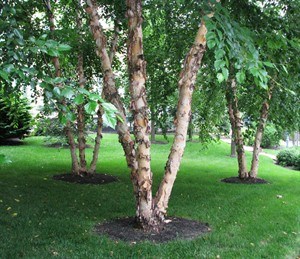
This undated photo shows "lawbreaking" Heritage birches in Bryn Mawr, Pa. The variety name under which this plant was patented is Heritage; it was later trademarked Heritage. That's a no-no: a variety and trademark name must be different. (AP Photo/Lee Reich)
December 26, 2012 - 10:35 AM
The intricacies of plant patenting came home for me this past year with a shipment of strawberry plants.
Strawberry plants send out runners, thin stems on the ends of which new plants form, which themselves take root and bear fruits and send out more runners. Those daughter plants forming at the ends of runners are useful for filling in a strawberry bed as well as for transplanting elsewhere to make a new bed.
But these particular plants that I bought last spring were a patented variety (Chandler). So transplanting those daughter plants would constitute a crime.
How about just letting the plants root by themselves? OK, but only for fruit production to fill in my strawberry bed. Propagation of any plant produced asexually (that is, not by seed) just to make new plants is forbidden under the Plant Patent Act of 1930.
The only exceptions are plants propagated by edible tubers — white potatoes, for example. Growers of white potatoes evidently were vocal enough back when the Act was being drafted to press for the right to save and replant their own potato tubers.
THE BEGINNINGS OF PLANT PROTECTION
Some might argue that the Plant Patent Act was too long in coming. If it had been in place earlier, then Stark Brothers Nursery, which bought propagation rights to the original Red Delicious apple for $3,000 in 1894, would not have had to erect a cage around the original Red Delicious tree. That cage only stopped people from using the original tree for propagation, however; once Stark Brothers started selling trees, those trees could be used by anyone to propagate new ones.
ON TO SEEDS, EVEN GENES
The 1930 legislation was broadened, in 1970, with the Plant Variety Protection Act.
It meant that seeds, which are sexually produced when pollen fertilizes eggs, could now also be protected by patents — so-called utility patents. That's the same kind of patent used for, say, a new and better stapler or dog whistle or — more recently and controversially — genes.
To be offered patent protection, a seed variety must not have been sold in the U.S. for longer than a year, or elsewhere for longer than four years. The variety must also reproduce reliably and be distinct.
Distinctiveness has always been a potential bone of contention, especially since DNA fingerprinting can now be used to unlock a plant's genetic code, some of which is just "junk," not expressing any trait.
Patents are valid for about 20 years, after which anyone can propagate the plant for sale or otherwise. Someone could even then produce hybrid seeds, produced by crossing specific parents, because patents, available for anyone to see, spell out exactly how a product is made.
WHAT'S IN A NAME?
Enter trademarks. Whether or not a plant has been patented, it could be assigned a trademark name. What's more, that trademark is assigned to a company or individual, who could put that name on any of their plants, even a few different ones. A patented variety also could be marketed under more than one trademark.
A patented plant is one thing and a trademark name another. Patents have a limited life; trademarks can be renewed indefinitely, which makes them useful. If you start selling some outstanding patented plant under a trademarked name, people will continue to buy it under that trademark even after the patent expires. Other people could propagate the patented plant, but could not sell it under your trademark.
A plant label stating "PPAF" (plant patent applied for) means, for plants, the same thing as "patent pending" for anything; "PVR" (Plant Variety Rights) means the plant has been patented. A plant may be patented, though, without it stating so on its label. Names of trademarked plants are followed by the symbol "(at)."
I recently learned that three birch trees I planted have broken a rule about patenting and trademarking. They are Heritage birches. The variety name under the patent is Heritage, and the plant was later trademarked Heritage. That's a no-no: a variety and trademark name must be different.
Oh well, I'm not the one who broke the rule, and the plant is pest-resistant and beautiful desspite its brush with the law.
___
http://leereich.blogspot.com/
http://leereich.com/
News from © The Associated Press, 2012